Understanding the Details of Wind Surfing Wings
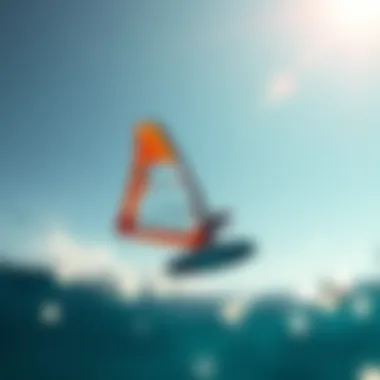
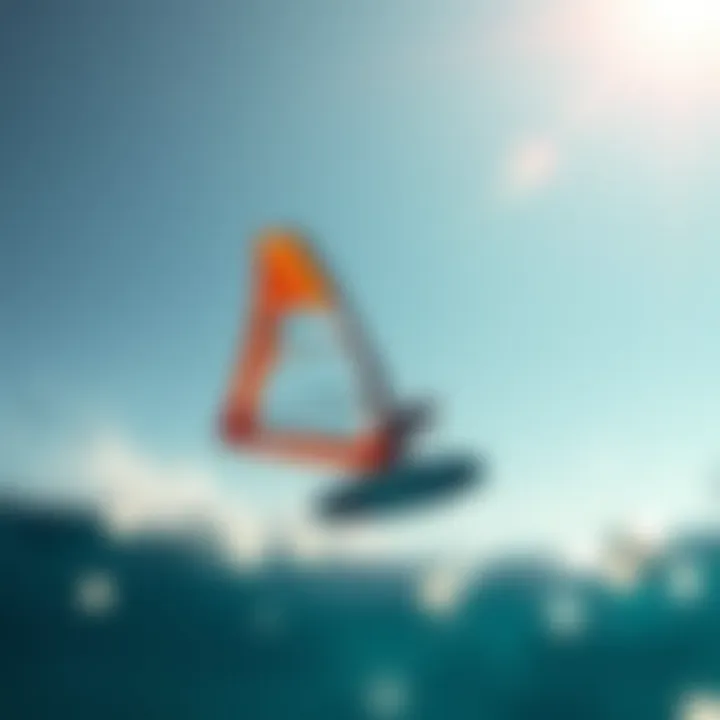
Intro
Wind surfing wings are more than just colorful sails gliding on the water's surface; they represent a fusion of technology, design, and the age-old human connection to the elements. Understanding these wings is essential not only for enthusiasts but also those just dipping their toes into the sport. The ins and outs of wind surfing wings involve an exploration into materials, mechanics, and the craftsmanship behind their construction.
Today’s wind surfing wings have seen significant advancements. The transition from traditional setups to modern wings reflects evolving needs in performance and versatility. Material innovations and design tweaks allow surfers to excel across a variety of conditions, giving anyone a chance to feel like they’re flying across the water.
This guide aims to break down the nitty-gritty of wind surfing wings in a way that's accessible yet thorough. If you're a beginner, this article can prevent you from getting lost in jargon and tech specs. For the seasoned riders, consider it a chance to refine your understanding and get tips for your next upgrade. As we journey through the intricacies of wind surfing wings, we'll uncover how to select the right gear, enhance your skills, and appreciate the broader implications of wind surfing in the world of outdoor activities.
Gear and Equipment
Essential Kiteboarding Gear for Beginners
Stepping into the world of wind surfing requires a solid understanding of the gear at one's disposal. Selecting the right equipment can shape the entire experience on the water. For beginners, a wate of thought into what to purchase can save either time or a whole mess of frustration.
- Windsurfing Wing: At the core of your setup, a good-quality wing is paramount. Look for something that balances durability with weight efficiency. For instances, brands like Duotone and Naish offer options for newcomers that are user-friendly and versatile.
- Board: Typically, beginners benefit from a wider board that offers stability and ease of use. It can be a good choice to start on a board that floats well, aiding balance.
- Harness: A comfortable harness will save your back during lengthy sessions. There are options like seat harnesses that provide extra support and spread the pull of the wing across the body.
- Safety Gear: Don't skimp on safety. A helmet can be crucial, as well as a impact vest.
Advanced Equipment for Experienced Riders
Once you've got the basics down, upgrading your kit can elevate your performance dramatically. Riders who have experience under their belts often look for finesse in gear.
- High-Performance Wings: Experienced users may want wings with advanced profiles tailored to specific riding styles. Companies like Slingshot offer wings with enhanced lift and handling.
- Performance Boards: The market is flooded with lighter and sleeker models for those who want speed and agility. Boards made from carbon composite materials can slice through the water effortlessly.
- Specialized Harnesses: With more time on the water, individuals might explore different harness styles that suit their riding preferences. Many pros opt for waist harnesses for improved maneuverability.
- Upgraded Lines and Foils: As your skills progress, you might also consider experimenting with different lines for optimal responsiveness.
This gear not only assists in technical progress but also enriches the overall experience of the sport.
"Investing in quality gear can transform not just performance, but also your connection to the wind and water."
Techniques and Tips
Basic Riding Techniques for Newbies
Kickstarting your journey in wind surfing might seem daunting, but with some straightforward techniques, you'll be zipping across the surface in no time. Here are a few basic tips:
- Stance: A solid stance is crucial. Stand with your feet hip-width apart, knees slightly bent, and your weight centered.
- Control Your Wing: Learn to find the sweet spot where the wing catches the wind without overpowering you. This balance defines the ride.
- Turning: To change direction, lean slightly in the direction you wish to go while adjusting your wing accordingly.
Expert Tricks to Elevate Your Skills
As you grow more confident, consider incorporating these expert tricks to amp up your game:
- Jumps: Getting air requires a blend of speed, timing, and wing technique. Practice it gradually – like a sprinter before a big race.
- Demos: Watching skilled riders can provide inspiration. Observe their body position and wing management; there's much to learn from simply observing.
- Condition Adaptability: Adjusting techniques based on wind and water conditions can push your limits, making each outing unique.
Each ride not only refines your skills but also your understanding of the natural environment around you.
Exploring wind surfing wings opens up a whole new world. With the right gear and techniques, the allure of gliding over water can easily become a passion that drives you to the beach time and again. For deeper dives into the sport, consider checking resources such as WindSurfing Wikipedia or forums on Reddit to connect with fellow enthusiasts.
Prolusion to Wind Surfing Wings
When it comes to water sports, wind surfing wings have made a splash that’s hard to ignore. These wings represent not just a piece of equipment but an exhilarating way to harness the power of the wind. Understanding wind surfing wings is essential for anyone looking to dive into this sport or refine their existing skills. Through grasping the nuances of these wings, enthusiasts can unlock an entirely new level of performance and fun on the water.
Historical Overview
To appreciate where we are today, it’s crucial to take a stroll down memory lane. Wind surfing has its roots in the late 1960s, with a combination of both surfing and sailing. The pioneers were few, but they had big dreams. They envisioned a hybrid board that would let riders glide on water, propelled by the wind. The original designs were rudimentary, often resembling a surfboard with a sail attached. Over the decades, these concepts have morphed significantly, leading to the advanced wings we know today.
Modern wings have been inspired by various innovations, marrying the effectiveness of kiteboarding with the grace of surfing. From materials to design, the evolution of wind surfing wings tells a story of creativity, experimentation, and the relentless pursuit of performance. Initial wings were often heavy and cumbersome, but now, thanks to advancements in materials and aerodynamics, they are light enough for just about anyone to master.
The Evolution of Techniques
As wind surfing gained traction, so too did the techniques used to ride. Early adopters had to contend with clunky equipment that didn’t always cooperate. However, as new generations took to the water, they developed innovative techniques that have since become standard practice. For instance, the basic stance used in wind surfing—keeping your feet shoulder-width apart and bending your knees—has not changed much, but the way riders now harness the wind has.
Countless tricks and angles can be employed to achieve more lift or speed. Riders began leaning back and shifting their weight to manipulate their wings more effectively, leading to thrills and spills alike in equal measure.
Today, the techniques range from simple maneuvers suitable for beginners to complex aerial tricks that are a feast for the eyes. Wind surfers have climbed the ranks from novice to expert through a blend of intuition, practice, and understanding of their equipment. Knowing how to read the wind and water conditions is a skill in itself, and mastering these can be the difference between a satisfying day on the water and a frustrating one.
In summary, the journey through the history and evolution of techniques surrounding wind surfing wings not only enriches the understanding of the sport but also highlights the constant evolution of wind surfing itself. With this foundational knowledge, one can better navigate the exciting terrain of modern wind surfing.
Understanding the Mechanics
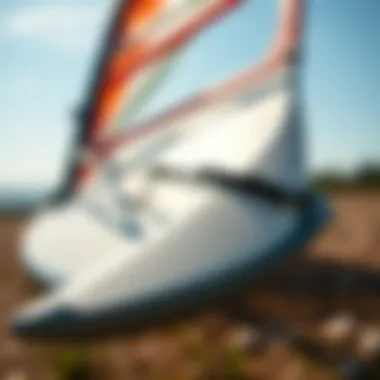
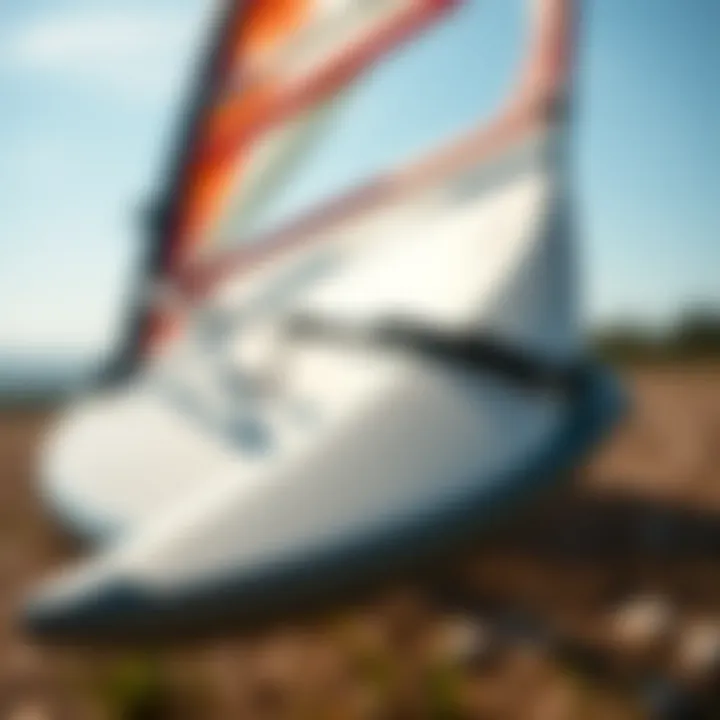
When it comes to wind surfing wings, understanding the mechanics isn’t just about grasping physics; it’s crucial to mastering the art of riding. This section sheds light on the tribulations that occur in the world of wind, how wings engage with this elemental force, and the broader implications for performance.
Lift and Drag Forces
Lift and drag forces are paramount in any form of aerodynamics, and wind surfing is no exception. Lift, the upward force acting against gravity, is generated when air flows over the wings. The design of the wing, be it the aspect ratio or the camber, influences how effectively it can generate this lift. A fundamental example can be seen in a flat kite-like wing; it may produce adequate lift under the right conditions, yet may face challenges under variable wind speeds, turning it into a struggle instead of a glide.
Conversely, drag acts against the direction of motion, hindering speed. Think of drag as the leaky bucket in your quest for faster rides. It's essential to strike the right balance between lift and drag, ensuring that the kite can harness wind energy efficiently while minimizing resistance. A sleek, streamlined design can help in overcoming drag by channeling airflow smoothly over the surface, ultimately enhancing speed and control.
Consider the uses of advanced materials like ripstop nylon or even mylar, which are often employed to minimize weight while maximizing wind responsiveness. Easier said than done, right? But skipping on understanding these forces could mean the difference between a successful day on the water and an exhausting battle against the elements.
"Effective wing design is not merely about aesthetics but profoundly hinges on physics—an enthralling dance between lift and drag that sets the tone for every ride."
How Wings Generate Power
Wings generate power by harnessing the wind's natural motion and converting it into thrust, a critical aspect for any serious wind surfer. At its core, this transformation involves several factors: angle of attack, wind speed, and wing shape. The angle of attack, the inclination of the wing relative to the oncoming wind, can drastically alter the performance. A higher angle may generate more lift but can cross the fine line into stall territory if not managed properly.
Furthermore, recognizing the wind conditions plays a vital role in maximizing power generation. The interplay between wind speed and wing surface can turn a gentle breeze into a turbocharged ride. A larger wing, for instance, might seem appealing on a calm day, yet it can become cumbersome when winds pick up. A well-versed wind surfer learns not just to feel but to anticipate these shifts.
It's notable to mention that the performance of wind surfing wings is continually improving, with cutting-edge designs and materials enhancing efficiency. The evolution of wings toward lighter, stronger builds enables surfers to push the envelope like never before. Being able to adapt to varying energy levels from the wind translates directly into smoother turns and sustained momentum.
In summary, comprehending the mechanics of lift and drag and how wings create power is fundamentally about ensuring a harmonious relationship with the wind. The more you know, the better equipped you are to ride those waves, leaving your competitors in your wake. Essential resources for further insight on this topic include the Wikipedia article on Aerodynamics and discussions on Reddit for community insights about windsurfing.
Ultimately, mastering these principles can transform your approach to wind surfing, allowing both novices and seasoned riders to delve deeper into the sport.
Material and Design Innovations
The realm of windsurfing has seen substantial evolution over the years, particularly in the materials and design of wings. These innovations have revolutionized the experience on the water, showcasing how effective engineering can optimize performance while ensuring safety. Understanding these advancements not only enhances your experience but also maximizes your potential on the board. This section will guide you through the current material trends and the aerodynamics in design that shape today's wings.
Current Material Trends
When it comes to windsurfing wings, the materials used play a crucial role. The most sought-after materials today include polyester, epoxy, and carbon fiber. Each of these materials comes with its distinct advantages. For instance, polyester offers a balance between cost and durability, making it a practical choice for beginners.
On the other hand, carbon fiber stands out for its lightweight properties and incredible strength, often making wings significantly easier to maneuver in challenging conditions. Epoxy, known for its rigidity and impact resistance, complements both performance and longevity, emphasizing the importance of selecting the right material for your specific needs.
The trend has also shifted towards sustainable materials. Many manufacturers are exploring bio-resin options, which not only reduce the carbon footprint but also promote sustainability within the sport. Adopting these newer materials can sometimes demand a higher investment, yet the benefits often outweigh the costs, ensuring enhanced performance and a reduced environmental impact.
Aerodynamics in Design
Aerodynamics holds the key to performance in windsurfing. A well-designed wing can make a world of difference in the rider's overall experience, particularly concerning speed, stability, and control. Factors like profiling and weight distribution are central to achieving optimal aerodynamic efficiency.
Profiling for Performance
Profiling is about the shape and contour of the wing, which directly affects how air flows over the surface. A well-profiled wing can drastically improve lift while minimizing drag, creating a smoother ride. The conventional design combines a curved leading edge with a flatter trailing edge to direct airflow more efficiently.
A key characteristic of effective profiling is its adaptability to various wind conditions. Wings designed with different profiles can perform better in light breezes, while others master stronger gales. This versatility is why many enthusiasts prefer wings with adjustable profiles, allowing them to tailor their ride according to their environment.
The unique feature of profiling is its potential to reduce turbulence. With less drag, riders can attain higher speeds without consuming more energy, enhancing performance overall. However, this engineering finesse comes with the downside of requiring precise calibration; an improperly set profile can lead to erratic handling.
Weight Distribution Strategies
Keeping the weight balanced plays a tremendous role in the handling and agility of the wing. Weight distribution refers to how the mass is distributed across the wing, which affects stability, responsiveness, and overall handling.
A key characteristic of effective weight distribution is its impact on rider comfort. Well-distributed weight allows for easier navigation through waves and gusts, resulting in a more controlled experience. An innovative approach in recent designs involves strategically placing weight in critical areas, allowing builders to enhance maneuverability without sacrificing stability.
The unique advantage of these strategies is providing riders with a sense of security. It facilitates quick responses in shifting wind conditions while maximizing user comfort. However, the challenge lies in the optimization; improper weight distribution can lead to instability, transforming a pleasant ride into a harrowing experience.
"Selecting your windsurfing wing is like choosing the right tool for a specific job—understanding its material and design is essential for a successful and enjoyable experience on the water."
In summary, the myriad innovations in material trends and aerodynamic design strategies define the modern windsurfing wing. Staying informed on these advancements empowers riders to make educated choices tailored to their skill level and preferred riding conditions, ultimately enhancing their experience on the water.
External Resources:
- Wikipedia: Windsurfing
- Britannica: Windsurfing
- Reddit: Windsurfing Community
- National Park Service: Outdoor Safety Tips
- Kiteboarding and Windsurfing Community
Selecting the Right Wing
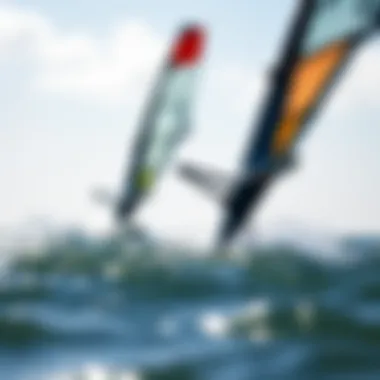
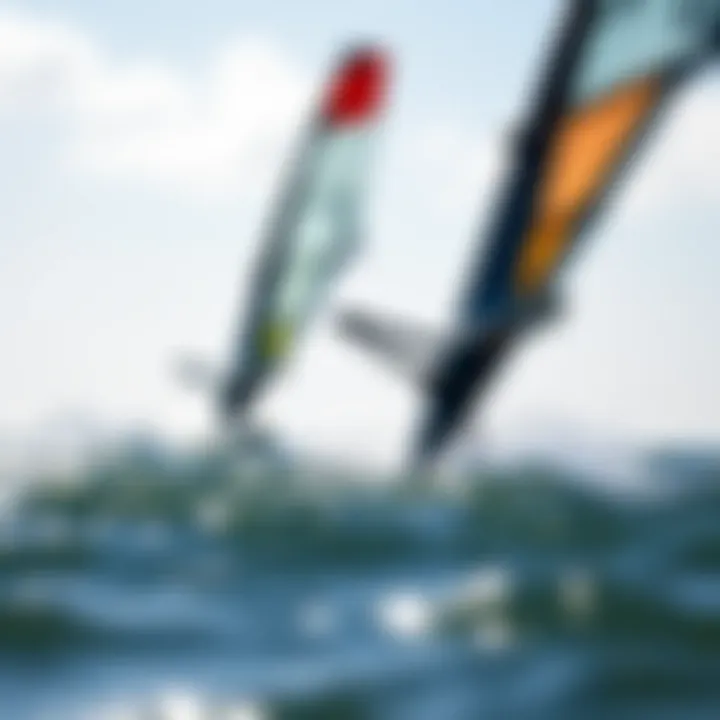
Choosing the appropriate wing is paramount for any wind surfer, whether a novice just starting out or a seasoned pro looking to expand their horizons. The wing not only affects how you ride but also influences your overall experience on the water. A well-suited wing can transform your time on the waves, making it more enjoyable and safer. This section delves into critical aspects that inform your decision when selecting the right wing for your needs.
Understanding Your Skill Level
Your skill level significantly impacts your choice of wing. A beginner might feel overwhelmed by a large, high-performance wing which usually requires more skill to manage effectively. Instead, a smaller, more stable wing can make the learning curve less steep and more enjoyable.
- Beginners: Should opt for wings designed with stability in mind. These wings typically allow for easier handling and more control, important for those still finding their balance on the water.
- Intermediate: Those who have mastered the basics may wish to experiment with wings that are slightly larger or more aggressive. This can provide an edge in terms of speed and maneuverability, allowing for a gradual transition into more complex maneuvers.
- Advanced: Experienced windsurfers often seek high-performance wings that prioritize speed and agility. These wings can be difficult to handle but offer immense satisfaction to those well-versed in wind dynamics.
Weather and Wind Conditions
Understanding the local weather patterns plays a crucial role in your wing selection. Wind strength, direction, and temperature can affect how well your wing performs, making it essential to check conditions before you head to the water.
- Light Winds: For conditions with less wind, a larger wing is ideal. It provides the necessary lift to get you riding without requiring excessive wind speed.
- Strong Winds: Conversely, when the winds pick up, a smaller wing allows for better control and reduces the strain on your body. Strong winds can turn a large wing into a handful, compromising your safety and enjoyment.
- Temperature Considerations: The air temperature can also affect wind strength, which in turn impacts wing performance. Warmer air can lead to better lift in some regions while cooler conditions might require a more robust wing.
Choosing Based on Board Type
The type of board you use can also dictate your wing choice. Different boards have unique characteristics, such as weight and buoyancy, that pair better with specific wings.
- Lightweight Boards: For those riding lighter boards, a larger wing complements the buoyancy by maximizing lift. This combination works well for tricks and fast speeds.
- Heavy Boards: Heavier boards typically require powerful wings to maintain lift and maneuverability.
- All-Around Styles: If you enjoy versatility, consider a medium wing. It provides a balance that can adapt to different types of boards and riding styles.
In summary, selecting the right wing is a nuanced process that demands attention to personal skill, weather conditions, and board compatibility. Tailoring your choice based on these elements will lead to a more fulfilling windsurfing experience.
"Choosing the wrong wing can make a day on the water frustrating instead of exhilarating, so take the time to find what suits you best."
For more insights on windsurfing dynamics, you might check out resources from Wikipedia's Windsurfing page or discussions among enthusiasts on Reddit.
Your adventure on the water begins with the right wing, so choose wisely.
Safety Considerations
In the exhilarating world of wind surfing, safety is paramount. Whether you are a rookie navigating your first waves or a seasoned pro performing advanced tricks, understanding safety considerations is essential to enjoying the sport responsibly. Wind surfing, with its unique balance of thrill and risk, requires knowledge of gear, environmental conditions, and emergency response protocols.
Adopting proper safety measures can enhance your confidence and provide peace of mind as you glide across the water. Making informed decisions about your equipment and surroundings can prevent unnecessary accidents. It’s not just about personal safety; it’s about fostering a culture of responsibility in the wind surfing community.
Essential Safety Gear
Having the right gear is like having a sturdy ship on a stormy sea. Essential safety gear for wind surfing varies but typically includes:
- Life Jacket (PFD): A personal flotation device is critical, particularly in choppy waters or for beginners. It keeps you buoyant should you find yourself in the drink unexpectedly.
- Helmet: Protects your head from potential falls or collisions. While it might not be the first thing that comes to mind, a helmet can be a lifesaver.
- Impact Vest: Additionally, an impact vest offers protection against the gusty winds as well as helps with your buoyancy. It can make those rough landings feel a little less harsh.
- Booties or Footwear: Proper footwear will shield your feet from sharp objects in the water, like coral or glass. They also provide better grip while maneuvering.
- Leash: A leash keeps your wing attached to your board, preventing it from drifting away if you dismount.
- Safety Whistle: This device is often overlooked but can be crucial in alerting others for help in case of an emergency.
Investing in quality gear not only helps in your safety but also in your overall experience. You don’t want to be left high and dry due to improper equipment.
Recognizing Weather Patterns
Understanding the weather is a skill that can save you from potential danger. Wind surfing is largely dependent on the condition of the elements, so being able to read the sky and anticipate weather changes is crucial. Certain patterns are telltale signs of changing conditions:
- Wind Direction and Speed: Pay attention to wind behavior. Abrupt changes can signal gusts, and strong winds might not always be your ally, especially if you’re new to the sport.
- Clouds and Precipitation: Dark clouds typically mean rain or storms are brewing. A sudden cloud build-up can kick up wind dramatically, which may not be safe for riding.
- Local Weather Patterns: Each location has its quirks. Some places experience microclimates, where the weather can change unexpectedly. Keep yourself informed about local conditions.
- Tides and Current: Overlooking tide changes can be dangerous. Strong currents can drag you unexpectedly far from your starting point, making it vital to consult tide charts before heading out.
Being aware of these patterns can ensure that your adventure remains fun rather than frightening. It's like drawing an invisible line in the sand; knowing where to ride and when can mean the difference between a joyful outing and an unwanted trip back to shore.
Remember: Safety isn’t just gear; it’s awareness. It’s what keeps the sport enjoyable and sustainable for everyone.
Techniques and Tips for Success
Mastering the art of wind surfing wings involves more than just hitting the water and flying with the breeze. The right techniques and tips play a crucial role in enhancing your overall experience and boosting performance. This section is crucial as it arms both newcomers and experienced riders with knowledge that can make or break their time on the waves. From basic techniques to advanced tricks, understanding these nuances can set the stage for a much more satisfying ride.
Fundamental Techniques for Beginners
Starting with the basics, it is vital for beginners to grasp some fundamental techniques that lay the groundwork for their windsurfing journey. Here are a few key points:
- Foot Positioning: Proper foot placement can be the difference between a smooth sail and a chaotic fall. Beginners should keep their feet shoulder-width apart, which ensures better balance and control over the board. This stance also aids in preparing for turns and responds effectively to the wind.
- Body Positioning: Leaning slightly forward can help shift your center of gravity. This technique promotes stability and allows you to maintain control.
- Harness Use: A significant part of windsurfing relies on using the harness to connect to the sail. When used properly, your arms can relax, freeing you to focus on balancing and navigating. Practice hooking in and out of the harness to get comfortable.
- Reading the Wind: Understanding how to read the wind direction is essential. Watching for consistent gusts and shifts can help you maneuver effectively. Always be aware of changing weather patterns, as they can influence your riding experience.
- Practice Sailing Upwind: Learning to sail upwind may feel challenging at first, but it's crucial for improving overall technique. Navigating into the wind means you become adept at controlling the sail while balancing the board.
"Learning to wind surf is akin to learning a new language; once you understand the lingo of the wind and water, everything falls into place."
Having a solid grasp of these foundational techniques brings you closer to mastering the ride and enables you to enjoy the sport safely.
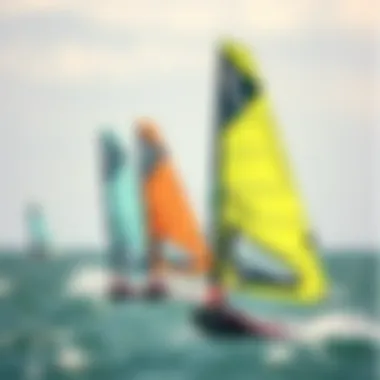
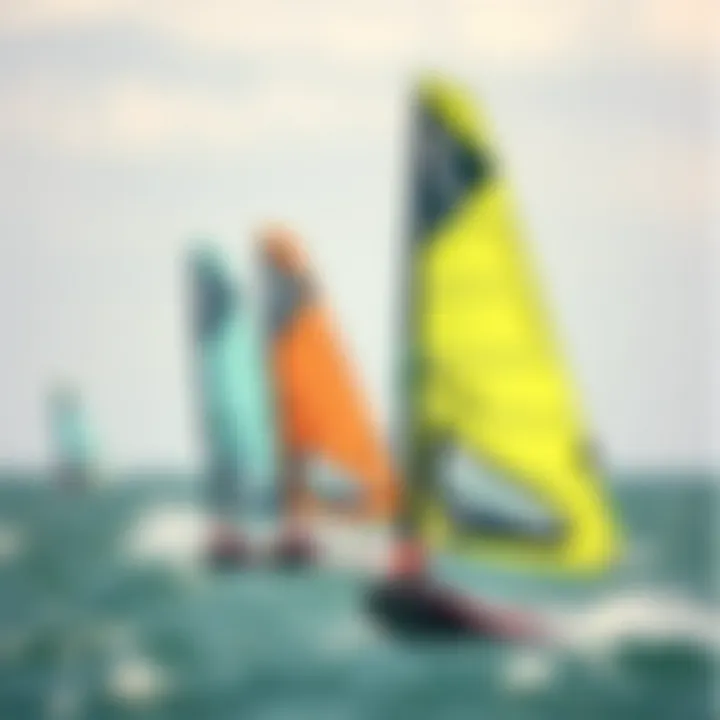
Advanced Maneuvers and Tricks
Once you’ve got the basics down pat, diving into advanced maneuvers opens up a world of possibilities. Here are some techniques that can elevate your windsurfing game:
- Tacks and Jibes: These are the bread and butter of windsurfing navigation. Practicing seamless tacks (turning to change direction while sailing upwind) and jibes (turning while sailing downwind) enhances your control and allows fluid transitions.
- Jumping: Once comfortable on the water, jumping begins with the right speed and a good ramp. Timing your take-off to catch the wind under the board is essential. As you leave the water, keep your knees slightly bent, and focus on your landing.
- Tricks like the Forward Loop: This exhilarating trick requires speed, commitment, and a good sense of timing. As you approach the jump, throw your head back and pull the sail in tight, allowing the board to rotate under you.
- Aerial Maneuvers: Involves tricks like spins and flips that can wow spectators. For these, the key is to gain enough height and execute your moves before your descent.
- Utilizing Waves: If you’re near waves, learn how to ride them. Wave riding takes finesse, understanding the wave's peak, and knowing when to attack to take full advantage of the water's power.
These advanced techniques and tricks can significantly enhance your experience on the water, making windsurfing not just a sport, but an adventure. The excitement from successfully executing a maneuver can be incredibly rewarding.
In summary, whether you’re just starting out or pushing your limits in advanced tricks, the techniques and tips outlined here are bound to aid your progress and enjoyment in the world of windsurfing wings.
The Impact of Wind Surfing on Water Sports Culture
Wind surfing has profoundly influenced water sports culture, carving a niche that extends beyond simple recreation. It represents a blend of athleticism, artistry, and community spirit. When individuals engage in this sport, they don’t just ride the waves; they become part of a broader discourse about environmental consciousness, physical fitness, and social connectivity.
Community Dynamics
The community surrounding wind surfing is as diverse as the sport itself. Whether you’re a seasoned rider or just taking your first steps on a board, the camaraderie found among enthusiasts is palpable. Events often gather individuals from various backgrounds—be it local thrill-seekers or international competitors—creating a tapestry of shared experiences.
This communal aspect fosters an environment where knowledge is freely exchanged. Beginners can seek guidance from veterans, allowing the transfer of skills and insights, which enhances the overall experience for everyone involved. Specific forums and social media groups have become breeding grounds for conversations, tutorials, and even debates about the latest gear and techniques. This exchange not only strengthens personal connections but also cultivates a collaborative spirit focused on improving the sport as a whole. For more discussions, check out the communities on Reddit or popular platforms like Facebook.
Maintaining an inclusive atmosphere, many local clubs host recreational events, open to all skill levels, thus breaking down barriers. This sense of belonging empowers participants and helps sustain a vibrant culture that can resist the pressures of commercialization.
Youth Engagement and Outreach
The importance of engaging youth in wind surfing cannot be understated. Initiatives aimed at young people are crucial in securing the future of the sport. Schools and local organizations are increasingly offering introductory courses, recognizing how these programs can enhance physical fitness and encourage an active lifestyle. Beyond the exercise aspect, wind surfing cultivates resilience, discipline, and problem-solving skills.
Outreach programs play a pivotal role; they not only teach kids about the sport but also instill environmental awareness. Many of these programs incorporate lessons on the local ecosystem, emphasizing the importance of protecting waterways. Such educational efforts extend beyond the wind surfing community, embedding principles of sustainability into the younger generations.
Moreover, youth engagement initiatives often feature competitions and showcases, allowing young talents to demonstrate their skills. This not only motivates participants but also inspires spectators to visualize themselves as future competitors. As these young riders navigate their journeys, they contribute to the evolution and vibrancy of wind surfing culture.
The impact of wind surfing extends far beyond the shores; it’s a multi-faceted cultural phenomenon that champions community, collaboration, and conservation. As we examine this sport’s future, it is essential to acknowledge these dimensions that knit us together, reinforcing the values of respect, responsibility, and above all, a shared love for adventure.
Future Trends in Wind Surfing Wings
The world of wind surfing is ever-evolving, and keeping an eye on future trends is crucial for enthusiasts who want to stay ahead in the game. This section shines a light on the emerging technologies and shifts in sustainability that are shaping what lies ahead for wind surfing wings. Understanding these aspects not only enhances a rider’s experience but also aligns them with broader environmental considerations that are gaining traction in water sports culture.
Technological Innovations
Technological advancements are making waves in the design and functionality of wind surfing wings. The spotlight is currently on a few key areas:
- Materials Science: Innovations in the materials used to construct wings are paramount. Lightweight fabrics that are incredibly strong, like ultra-high-molecular-weight polyethylene, are becoming popular. These materials offer more durability without compromising on performance.
- Smart Technology Integration: With the rise of IoT (Internet of Things), expect to see wings equipped with sensors, tracking devices, and even wind speed monitors. This tech can provide real-time feedback, helping riders analyze their performance and make adjustments on the go. For example, a wing might send performance data to a connected app, giving insights about lift and drag metrics.
- Customizable Designs: 3D printing is now allowing for bespoke wing designs tailored to the specific preferences and skill levels of riders. This makes it easier for individuals to craft wings that fit their unique riding styles or conditions, enhancing their overall experience out on the water.
In summary, future wind surfing wings are expected to blend traditional craftsmanship with cutting-edge technology. If riders embrace these innovations, they will likely find their time on the water not only more enjoyable but also more efficient in terms of performance and safety.
Sustainability Efforts
As awareness about environmental issues grows, sustainability in wind surfing is becoming a pressing concern. Here are some of the main areas where sustainability is making an impact:
- Eco-Friendly Materials: Manufacturers are beginning to prioritize eco-conscious materials in their production processes. This means that more wings will be crafted from recycled plastics or sustainable fibers, which reduces waste and pollution.
- Production Processes: Companies are adopting greener practices, such as minimizing water usage and reducing carbon emissions during production. These practices are becoming a point of pride for brands, resonating with environmentally-focused consumers.
- End-of-Life Solutions: There’s a push for programs that facilitate recycling or repurposing of used wind surfing wings. The idea is to keep these materials out of landfills and give them a second life in new products or applications.
"Wind surfing is not just about the thrill of riding; it’s about riding responsibly for our future generations."
By integrating sustainability into both the materials and operational processes, the future of wind surfing wings is not just innovative but also conscientious. Riders are starting to seek out brands that reflect these values, thus making it a key factor in market differentiation.
The End
In summarizing the vast realm of wind surfing wings, it becomes clear that these tools are not merely sport accessories; they are inventions that carry deep implications for performance, safety, and experience on the water. Understanding the nuances of these wings can immensely enhance both the enjoyment and proficiency of riders at all skill levels. The consideration of factors such as design dynamics, material choices, and the impact of environmental conditions provides valuable insights into optimizing a rider’s experience and outcomes.
Summation of Key Insights
When diving into the world of wind surfing wings, key points emerge:
- Material Selection: The latest wings utilize advanced materials that improve durability and responsiveness. Whether it’s the rigid carbon reinforcements or lightweight fabric, each aspect plays a crucial role in performance.
- Performance Variables: Understanding lift, drag, and how wings generate power shapes a rider’s approach to mastering wind surfing. A rider’s ability to read the wind can significantly affect their maneuvers.
- User-Focused Choices: Selecting the right wing correlates closely with both weather and personal skill levels. Tailoring equipment to specific conditions can inspire confidence and lead to a more enjoyable experience.
This amalgamation of elements contributes significantly to the rider's repertoire. From board type to wind conditions, every decision hinges upon an informed understanding of what each wing can offer.
Encouraging Continued Exploration
The journey of exploring wind surfing wings shouldn’t stop at merely acquiring knowledge from a single article. There’s a rich community of enthusiasts and professionals who regularly share their experiences and insights across various platforms. Engaging with forums on Reddit or participating in local kiteboarding clubs can open doors to new techniques and innovations in the sport. You can often learn from seasoned surfers’ trial-and-error that solidifies understanding far better than theoretical knowledge alone.
On top of that, advancements in design and technology evolve at a rapid pace. Staying in tune with the latest trends in wing technology through resources like Wikipedia or targeted educational websites can keep anyone from novice to expert informed and ready to adapt.
Overall, the field beckons the interested to dive deeper, equip themselves with evolving knowledge, and foster connections within the water sports community. Wind surfing wings present a captivating blend of art and science, encouraging explorers to ride the winds of change.















